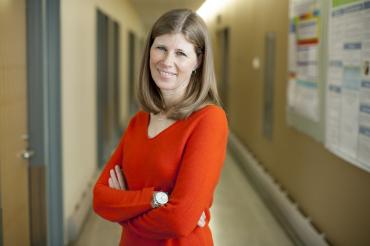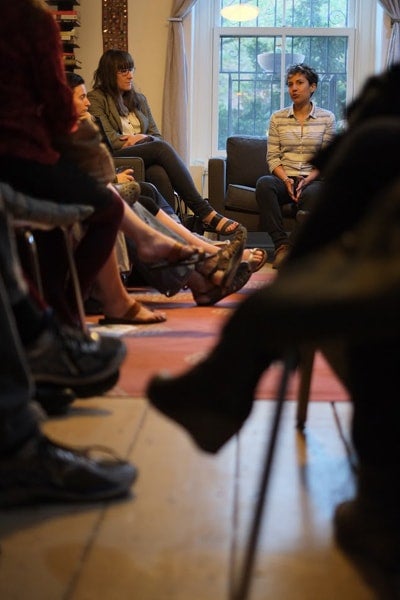Top emerging U of T scholars joining Royal Society of Canada’s new college

Published: September 13, 2016
A physical therapist involved in treating children with disabilities and an anthropologist studying animal activism may not seem to have much in common.
But at the heart of their research is a desire to change perceptions, to deepen discourse and disrupt or expand outmoded ways of thinking.
Today, physical therapist and bioethicist Barbara Gibson and anthropologist Naisargi Dave were among six U of T scholars named by the Royal Society of Canada as members of its College of New Scholars, Artists and Scientists. See the full list of recipients below.
In 2014, the society decided it needed to create a special college to recognize and foster scholarly leadership and interdisciplinary collaboration among Canada’s “new” generation of scholars, artists and scientists who’ve received their PhD within the last 15 years.
“It means a lot to be a part of it,” said Dave, who is hoping to finish writing her second book this academic year. “I was especially honoured that my senior colleagues sought fit to nominate me for this award.”
“I’m really excited about it. It’s a great honour,” added Gibson.
“The Royal Society of Canada is to be commended for their decision to recognize and support the work of Canada’s emerging scholars,” said Vivek Goel, U of T’s vice-president of research and innovation. “We’re extremely proud of U of T’s newest members of the College of New Scholars, Artists and Scientists and look forward to seeing new collaborations and more exciting work from them as a result.”
 Since publishing a book on queer activism in India, Dave (left, photo by Wan Park) has turned her attentions to animal-human relationships in the second most populous country in the world. Her research is challenging the commonly held notion that only upper class Westerners are concerned with animal welfare.
Since publishing a book on queer activism in India, Dave (left, photo by Wan Park) has turned her attentions to animal-human relationships in the second most populous country in the world. Her research is challenging the commonly held notion that only upper class Westerners are concerned with animal welfare.
She’s also exploring how clashes between what are seen as normative actions (which value consistency and placing issues in context as “good”) and non-normative actions (contradictions) play out in the animal rights activism sphere.
An example, she said, is how a vegetarian or vegan is often questioned about the contradictions in their conduct, e.g. not eating animals but wearing leather shoes. But “normative values rarely need to account for or explain themselves.”
In Gibson’s case, she’s pushing rehabilitation to expand its thinking beyond the confines of biomedicine to include newer areas of research that see disability less as a medical problem to solve and more of a social problem to tackle, e.g., I am disabled by my society, not by my body.
“What I’m interested in is how do we think, talk and add this to the discussion in everyday practice in rehabilitation?” said Gibson, a U of T associate professor and senior scientist at Bloorview Research Institute at the Holland Bloorview Kids Rehabilitation Hospital where she directs the Critical Disability and Rehabilitation Studies unit.
As part of her research, Gibson has interviewed young people with cerebral palsy, aged eight to 19, to hear first-hand how they view their experiences in rehabilitation.
Gibson says that professionals can now predict fairly accurately the likelihood of an individual child with cerebral palsy will be able to walk in adulthood. Nevertheless children continue to receive hours of therapy over several years. While she agrees it’s important for children with cerebral palsy to work at strengthening their muscles and keeping fit, she cautions that focusing too much on walking detracts from other pursuits.
“Therapy consumes a tremendous amount of energy, resources, time,” she says. “It leaves less time to just be a kid.”
In the research children were conflicted and ambivalent about the value of walking. When choosing whether to walk, crawl or wheel, they considered the amount of energy needed, the activity, the environment and their preferences. They didn’t necessarily see disability as a problem and expressed pride in the speed, colour or features of their wheelchairs.
“I’m not saying rehabilitation isn't valuable,” Gibson said. “What I’m trying to do is encourage clinicians to promote acceptance of diverse bodies and abilities and have these conversations with parents and kids.”
The six 2016 U of T members of the Royal Society of Canada’s College of New Scholars, Artists and Scientists are:
Faculty of Applied Science & Engineering
- Hani Naguib, department of mechanical and industrial engineering
Faculty of Arts & Science
- Naisargi Dave, department of anthropology
- Stephen I. Wright, department of ecology and evolutionary biology
Faculty of Medicine
- Barbara Gibson, department of physical therapy and Holland Bloorview Kids Rehabilitation Hospital
- Wolfgang Kuebler, department of surgery and St. Michael’s Hospital
- Sharon Elizabeth Straus, department of medicine and St. Michael’s Hospital



